What kind of things are there?
Natural Things
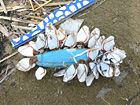 Goose barnaclesGoose barnacles attached to a float. They attach and grow on things that drift on the sea surface for a long period of time such as pumice and driftwood. |
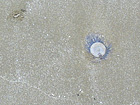 Blue button |
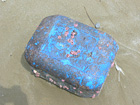 Acorn barnaclesAttach and grow on drifting debris such as plastic containers. |
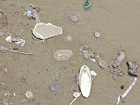 Blue button and cuttlefish shell |
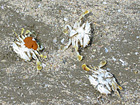 Flower moon crabs |
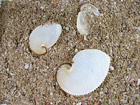 Greater ArgonautsAlso known as paper natilus, they are a species of octopus which create a splendid shell that resembles artwork. |
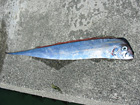 Slender ribbonfishSometimes said to be the inspiration for mermaids. (Kyoden Fishing Port) |
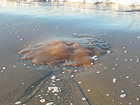 Nomura's jellyfishDeveloping in southern waters and then transported northward by the Tsushima Current. They adversely affect the fishing industry getting caught in fixed nets, yet on the other hand are an ingredient in Chinese cuisine. |
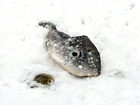 Unicorn leatherjacket (Thread-sail filefish)They are often washed up in winter. (Kyoden Fishing Port) |
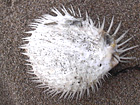 Porcupine fishCan be found washed up on the Sea of Japan coasts in winter. Born in southern regions such as the Philippines they are carried northward on ocean currents and washed ashore by monsoon winds. Although not eaten, they can still be found in folk tales from various places. |
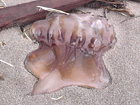 Nomura's jellyfishThey are still quite lively a while after being washed up. |
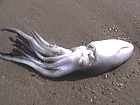 Squid |
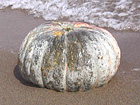 Pumpkin |
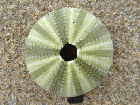 Sea urchinThe sea urchin shell without the spines. |
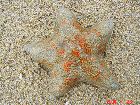 Starfish |
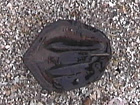 Walnut |
Manmade Things
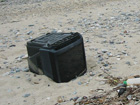 TVEven heavy objects such as this manage to drift in the sea. (Kyoden Fishing Port) TVEven heavy objects such as this manage to drift in the sea. (Kyoden Fishing Port) |
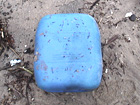 Plastic tankPlastic containers are reported washed-up on coasts of the Sea of Japan every year. In most cases the contents have already been washed out, although caution should be taken if found as some still contain irritating substances (hydrogen peroxide, etc.). Plastic tankPlastic containers are reported washed-up on coasts of the Sea of Japan every year. In most cases the contents have already been washed out, although caution should be taken if found as some still contain irritating substances (hydrogen peroxide, etc.). |
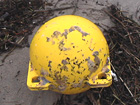 Plastic float (buoy)Those that have presumably been used in fishing operations such as with fixed nets. Plastic float (buoy)Those that have presumably been used in fishing operations such as with fixed nets. |
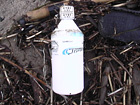 Plastic containerThere are Hangul characters on it, which implies that it was washed up all the way from Korea. Plastic containerThere are Hangul characters on it, which implies that it was washed up all the way from Korea. |
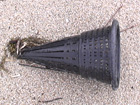 Fishing equipmentThe equipment shown is used to catch hagfish. Used together with a cylindrical pot, it is a device that makes it difficult for catch to escape once they have entered it. Although catches in Japan are small, this type of equipment is often seen along the coast of Toyama. Fishing equipmentThe equipment shown is used to catch hagfish. Used together with a cylindrical pot, it is a device that makes it difficult for catch to escape once they have entered it. Although catches in Japan are small, this type of equipment is often seen along the coast of Toyama. |
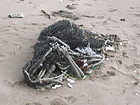 Fishing netsRemaining in the ocean, these encumbrances continue to entangle sea creatures with no relation to fishing industries (ghost fishing). Fishing netsRemaining in the ocean, these encumbrances continue to entangle sea creatures with no relation to fishing industries (ghost fishing). |
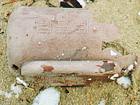 Octopus potAn octopus pot made of plastic with Hangul characters on it. (Matsudaehama Beach, Himi City) Octopus potAn octopus pot made of plastic with Hangul characters on it. (Matsudaehama Beach, Himi City) |
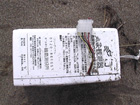 Weather-monitoring deviceShown is a device that has washed-up after falling to the sea surface having completed its monitoring of the weather. (Matsudaehama Beach, Himi City) Weather-monitoring deviceShown is a device that has washed-up after falling to the sea surface having completed its monitoring of the weather. (Matsudaehama Beach, Himi City) |
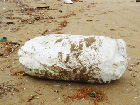 Plastic floatPolystyrene foam floats that deteriorate into small pieces are at risk of accidentally being swallowed by living things such as birds and fish. Plastic floatPolystyrene foam floats that deteriorate into small pieces are at risk of accidentally being swallowed by living things such as birds and fish. |
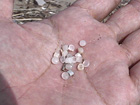 Resin pelletsA raw material of plastic approx. 3 to 5 mm in size. Accidentally released into the environment from plastic factories or while being transported. Similarly to polystyrene foam, there is a possibility that sea creatures will eat them by mistake. They are becoming a problem that can be found on almost every coast across Japan. Resin pelletsA raw material of plastic approx. 3 to 5 mm in size. Accidentally released into the environment from plastic factories or while being transported. Similarly to polystyrene foam, there is a possibility that sea creatures will eat them by mistake. They are becoming a problem that can be found on almost every coast across Japan. |
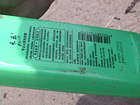 Plastic containerA shampoo bottle with Hangul characters on it. (Matsudaehama Beach, Himi City) Plastic containerA shampoo bottle with Hangul characters on it. (Matsudaehama Beach, Himi City) |
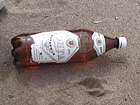 Plastic beer bottleA beer PET bottle made in Russia that is not used in Japan. Perhaps it was discarded from a ship. (Matsudaehama Beach, Himi City) Plastic beer bottleA beer PET bottle made in Russia that is not used in Japan. Perhaps it was discarded from a ship. (Matsudaehama Beach, Himi City) |
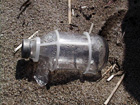 IV bottleMedical waste thought to have been disposed of illegally. Caution should be taken as syringe needles may also be nearby. (Shimao Beach) IV bottleMedical waste thought to have been disposed of illegally. Caution should be taken as syringe needles may also be nearby. (Shimao Beach) |
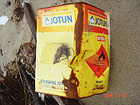 18-liter canAn 18-liter can with Hangul characters on it thought to have contained fuel. (Shimao Beach) 18-liter canAn 18-liter can with Hangul characters on it thought to have contained fuel. (Shimao Beach) |
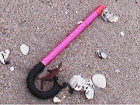 SnorkelPossibly a remnant of fun at the beach. SnorkelPossibly a remnant of fun at the beach. |
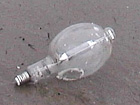 Fishing lampA fish luring lamp used on squid fishing boats, etc. Fishing lampA fish luring lamp used on squid fishing boats, etc. |




